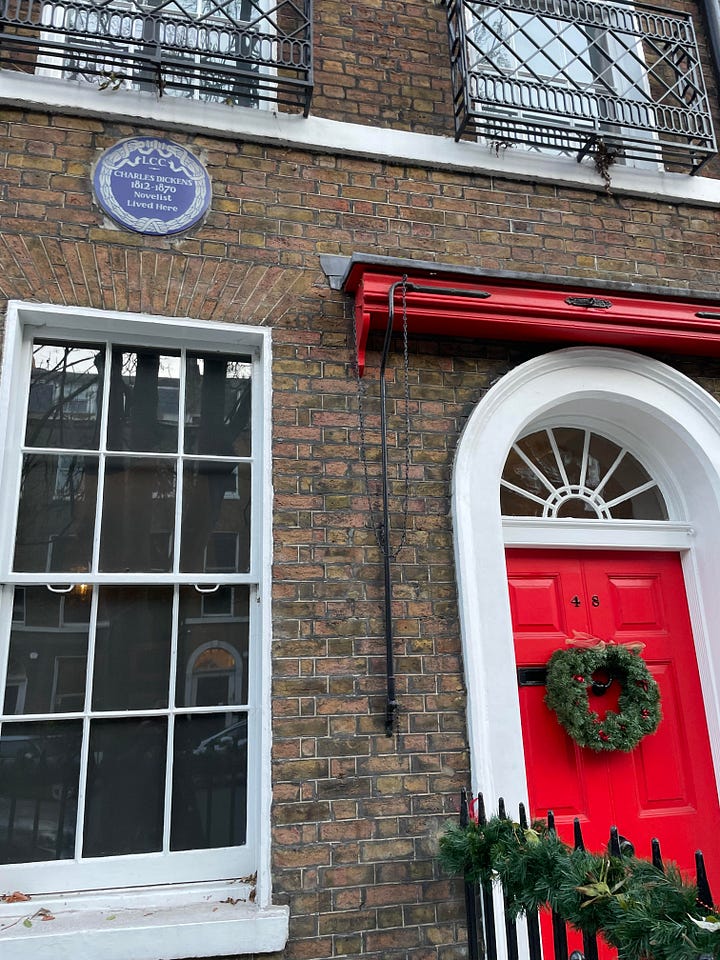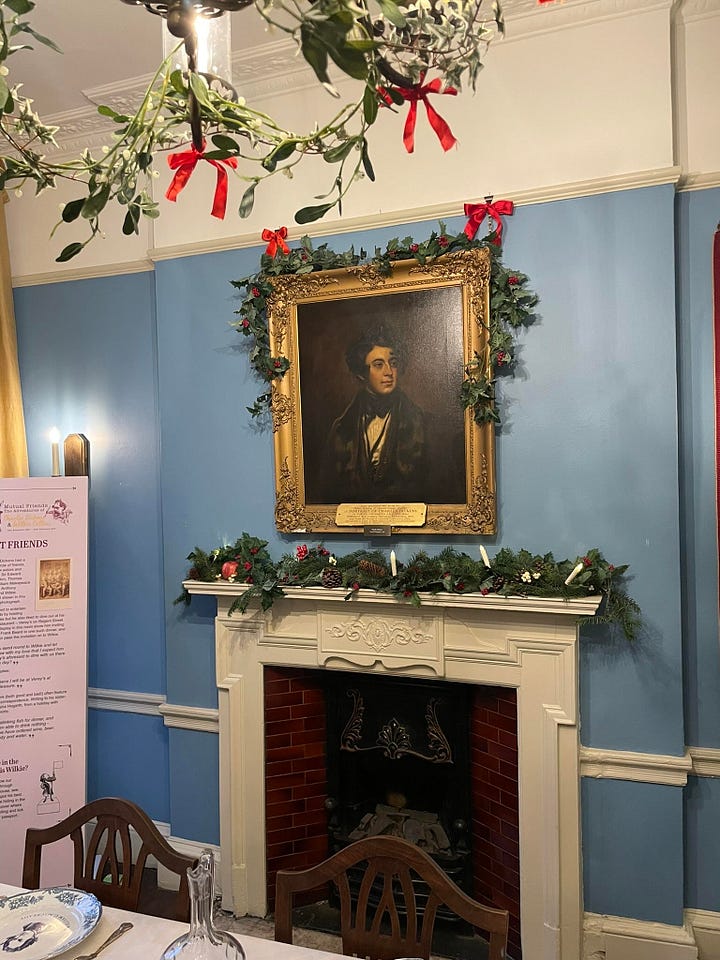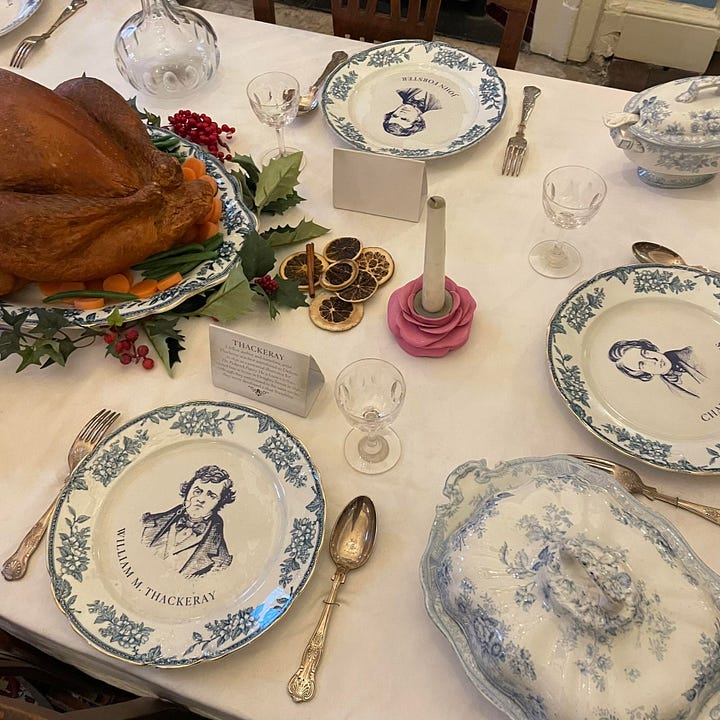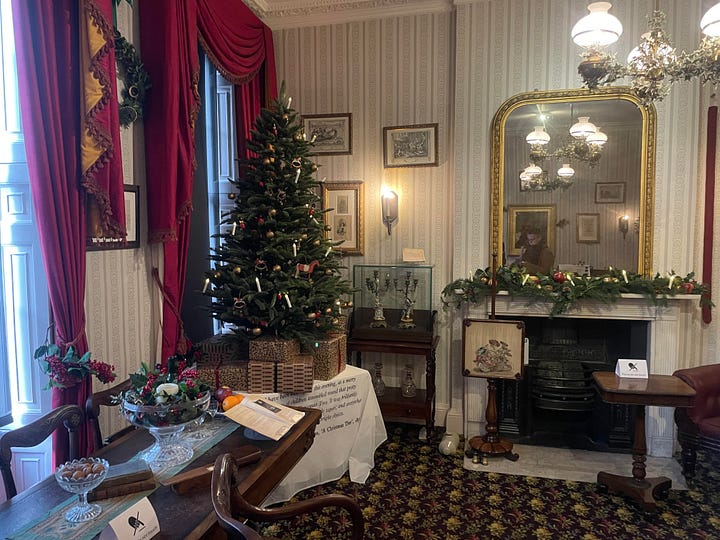Have Yourself a Merry Little Victorian Christmas: Exploring how the Victorians Reinvented Christmas, and the Presentation of Christmas in Nineteenth Century Literature.
‘I will honour Christmas in my heart, and try to keep it all the year. I will live in the Past, the Present, and the Future. The Spirits of all Three shall strive within me. I will not shut out the lessons that they teach.’ - Charles Dickens, A Christmas Carol.
Merry Christmas, everyone!
I have had a strong interest in the Victorian era for quite some time now, and one of the reasons why I find it such a fascinating period, is because of the reinvention and commercialisation of Christmas. Of course the celebration of Christmas long precedes the Victorian era, but many of the festive traditions and customs that we partake in and adhere to in the present day, can be attributed to the Victorians. For today’s post, I am going to ramble about some of the Christmas traditions that the Victorians gave us, and explore the presentation of Christmas in some of my favourite Victorian novels!
Victorian Christmas Traditions:
Queen Victoria came to the British throne in 1837 when she was only eighteen years old, and in the 1840s, Christmas as we know today, in many ways, was born. Perhaps the most famous Christmas tradition to come out of the Victorian Era is the Christmas tree. While Prince Albert, husband to Queen Victoria, is often credited for being the one to introduce Christmas trees to Britain in 1840, Queen Charlotte (1744-1818), wife to King George III (1738-1820) is actually the first known royal to have had a Christmas tree. In December of 1800, Queen Charlotte had a Christmas tree displayed in Windsor Castle, albeit hers was a yule tree, rather than a fir tree as Queen Victoria and Prince Albert’s would be a few decades later. So, while Queen Charlotte was the first to introduce Christmas trees to Britain, and credit must be given where it is due, Prince Albert introduced the fir tree which is still used today.
Christmas cards are another wonderful festive tradition that emerged in Victorian England. During the 1840s, advancements in postage, most notably the “Penny Post” introduced by Rowland Hill in 1840, allowed for Christmas cards to become a well established tradition. In December of 1843, Sir Henry Cole, a civil servant and inventor, printed a thousand cards in his art shop, selling them for a shilling each. People in the Victorian era then ‘exchanged, displayed, and collected Christmas cards in vast numbers. In the process, they established the now familiar iconography of Christmas.’ In 1894, the development of the “Halfpenny Post” was introduced, consequently bolstering the sale of Christmas cards.
The card above was designed by John Callcott Horsley. Henry Cole’s diary entry for 17 December 1843 records, “In the Evg Horsley came & brought his design for Christmas Cards”. Horsley personalised his card to Cole by drawing a miniature self-portrait in the bottom right corner rather than his signature, along with the date "Xmasse, 1843"1.
Another Christmas tradition that we can thank the Victorian for is Christmas pudding. However, it must be noted that while Christmas puddings gained popularity in Victorian England, their origin long precedes the Victoria Era, when they were often referred to as plum pudding. On the English Heritage website, there is a recipe for figgy pudding dated from 1392! In the Victorian Era, ‘plum pudding would come to epitomise Christmas and appeared on greeting cards and in satirical cartoons of the time. Rich or poor, every Victorian would expect a pudding as the finale to their festive meal’2.
Christmas crackers are another Christmas tradition that the Victorians gave us. The invention of the Christmas cracker is attributed to Tom Smith, a confectioner. Smith ‘patented his first cracker device in 1847, and perfected the mechanism in the 1860s.’ It was made using two narrow strips of paper layered together, with the silver fulminate painted on one side and an abrasive surface on the other - when pulled, friction created a small explosion. Smith’s son, Walter, added the elaborate hats, made of fancy paper, and sourced novelties and gifts from Europe, America and Japan3. His idea for the explosive pop sound was supposedly inspired by the sound of a crackling on the fire.
A Dickensian Christmas:
It is impossible to discuss Christmas in the nineteenth century without mention of Charles Dickens. Dickens published a series of Christmas short stories during the early Victorian era, most notably, A Christmas Carol. Published in December of 1843, the wonderful novella encapsulates the Victorian Christmas zeitgeist, and has immortalised many Victorian Christmas customs. In the novella, Dickens describes Christmas as
‘A kind, forgiving, charitable, pleasant time; the only time I know of, in the long calendar of the year, when men and women seem by one consent to open their shut up hearts freely, and to think of the people below them as if they were really fellow passengers to the grave, and not another race of creatures bound on other journeys.’ (stave one)
What makes the novella typically Dickensian, is its preoccupation with the plight of the poor. A Christmas Carol is an allegorical tale; Dickens employs the use of the supernatural for his social commentary on the abhorrent treatment of the poor in the early Victorian era. Dickens criticises the 1834 Poor Law Act, workhouses, and the economics of Thomas Malthus, particularly in Ebenezer Scrooge’s infamous line ‘If they would rather die, they had better do it, and decrease the surplus population.’ Scrooge, ‘a squeezing, wrenching, grasping, scraping, clutching, covetous, old sinner’ symbolises the greed and moral bankruptcy of the rich. Bob Cratchit, Scrooge’s employee, acts as Scrooge’s foil in the novella. Though financially poor, he and his family are rich in love, generosity, and gratitude. Although their Christmas dinner is frugal, they don’t allow it to dampen their festive spirits. Dickens describes Mrs Cratchit ‘dressed out but poorly in a twice-turned gown, but brave in ribbons, which are cheap’ and the Christmas pudding she bakes:
‘Mrs Cratchit entered – flushed, but smiling proudly – with the pudding, like a speckled cannonball, so hard and firm, blazing in half of half-a-quartern of ignited brandy, and bedight with Christmas holly stuck into the top.’ (stave three)
The Cratchit family symbolise what the Christmas spirit ought to be, in Dickens’ view; that Christmas is about being charitable and generous and valuing the people around you, rather than obsessing over material items like Scrooge.
Descriptions of Christmas in other Dickens stories:
A Christmas Tree (1850): ‘The tree was planted in the middle of a great table, and towered high above their heads. It was brilliantly lighted by a multitude of little tapers; and everywhere sparkled and glittered with bright objects. There were rosy cheeked dolls, hiding behind the green leaves; there were real watches dangling from innumerable twigs […] perched among boughs there were jolly broad-faced gentlemen […] there were teetotums, humming-tops, needle cases, pen wipes, smelling bottles, conversation cards, bouquet holders, imitation apples, pears, and walnuts, crammed with surprises. […] “there was everything and more.”’
Great Expectations (1861): ‘It was Christmas Eve, and I had to stir the pudding for the next day, with a copper stick, from seven to eight by the Dutch clock.’ (chapter two) ‘We were to have a superb dinner, consisting of a leg of pickled pork and greens, and a pair of roast stuffed fowls. A handsome mince pie had been made yesterday morning, and the pudding was already on the boil.’ (chapter four)
On the first of December, I visited the Dickens museum in London, and it was lovely to see it decorated for Christmas. The dining table was laid for Christmas dinner, garlands sat atop the fireplaces and had been weaved around the bannisters. All of the photo frames were adorned with strings of ivy and little red bows. The drawing room displayed a lovely Christmas tree with artificial tapers, and mistletoe hung from the overhead lights.




Christmas with the Little Women:
Louisa May Alcott’s 1868 novel Little Women, is a great book to read at this time of year because of its many mentions of Christmas. The novel opens with the March sisters feeling despondent about their financial situation:
‘“Christmas won’t be Christmas without any presents,” grumbled Jo, lying on the rug. “It’s so dreadful to be poor!” sighed Meg, looking down at her old dress. “I don’t think it’s fair that some girls have lots of pretty things, and other girls have nothing at all,” added little Amy, with an injured sniff. “We’ve got father and mother, and each other, anyhow,” said Beth, contentedly from her corner.’ (chapter one)
Beth’s response differs from that of her sisters and it is a very Dickensian view of Christmas: it emphasises the importance of family over pretty dresses and presents. However, this doesn’t make the other sisters bad people. A desire for nice things for Christmas is a normal part of being human, but it is important to not lose sight of what is more important.
On Christmas morning, the four sisters each receive a copy of The Pilgrims Progress (1678), an allegorical Christian tale by John Bunyan, as a present from their mother, ‘Marmee’. The gift of The Pilgrims Progress symbolises morality, and points to the sociopolitical situation of wider society at the time. The earlier parts of the novel take place during the early 1860s during the American Civil War. Meg explains this to her sisters.
‘You know the reason mother proposed not having any presents this Christmas, was because it’s going to be a hard winter for every one; and she thinks we ought not to spend money for pleasure, when our men are suffering so in the army. We can’t do much, but we can make little sacrifices, and ought to do it gladly.’ (chapter one)
Although Meg longs for a new pretty dress for Christmas, she understands that financial sacrifices must be made in light of the war. The importance of being charitable at Christmas is further accentuated when Marmee asks the sisters to give their Christmas breakfast away:
‘Not far away from here lies a poor woman with a little newborn baby. Six children are huddled into one bed to keep from freezing, for they have no fire. There is nothing to eat over there; the oldest boy came to tell me they were suffering hunger and cold. My girls, will you give them your breakfast as Christmas present?’ (chapter two)
The four sister agree immediately, and when they arrive home from delivering their breakfast to their impoverished neighbours, they are rewarded. Mr Laurence sends the girls a Christmas feast as a reward for their altruism. Both Dickens and Alcott stress the importance of being generous and charitable at Christmas.
A Brontëan Christmas:
There are mentions of Christmas in a few of the Brontë novels, but the presentation of Christmas in Wuthering Heights is my favourite because it is the most descriptive. When Catherine Earnshaw returns to Wuthering Heights from her five week stay at Thrushcross Grange, it is Christmas eve. Nelly, the housemaid, recalls how Catherine
‘kissed me gently: I was flouring the Christmas cake, and it would have done to give me a hug; and then, she looked around for Heathcliff. […] After playing lady’s maid to the newcomer, and putting my cakes in the oven, and making the house and kitchen cheerful with great fires, befitting Christmas eve, I prepared to amuse myself by singing carols […] I smelt the rich scent of the heating spices: and admired the shining kitchen utensils, the polished clock, decked in holly, the silver mugs ranged on a tray ready to be filled with mulled ale for supper. […] I remembered how old Earnshaw used to come in when all was tidied, and call me a cant lass, and slip a shilling into my hand as a Christmas box.’ (chapter seven)
Christmas day is disastrous at Wuthering Heights. Edgar and Isabella Linton visit, and Heathcliff is isolated from the festivities. When insulted by Edgar about his appearance, Heathcliff hurls a pot of applesauce at him. Charlotte Brontë also explores childhood loneliness at Christmas in Jane Eyre, as the ten year old Jane, like Heathcliff, is excluded from the festivities:
‘Christmas and the New Year had been celebrated at Gateshead with the usual festive cheer; presents had been interchanged, dinners and evening parties given. From every enjoyment I was, of course, excluded: my share of the gaiety consisted in witnessing the daily apparelling of Eliza and Georgiana.’ (chapter four)
The eighteen year old Jane enjoys a slightly happier Christmas after she abandons Mr Rochester and flees Thornfield Hall:
‘It was Christmas week: we took to no settled employment, but spent it in a sort of merry domestic dissipation. The air of the moors, the freedom of home, the dawn of prosperity, acted on Diana and Mary’s spirits like some life-giving elixir.’ (chapter thirty five)
There’s a small mention of Christmas in Anne Brontë’s The Tenant of Wildfell Hall, as Helen Huntingdon reflects on how much she has changed over the past year:
‘December 25th - Last Christmas I was a bride, with a heart overflowing with present bliss, and full of ardent hopes for the future - though not unmingled with foreboding fears. Now I am a wife: my bliss is sobered, my fears increased, but not yet thoroughly confirmed; and, thank Heaven, I am a mother too.’ (chapter twenty eight)
Emily’s depiction of Christmas is my favourite because she describes specific Christmas traditions such as Christmas pudding, decking the halls with holly, carol singing, and gift giving. The Brontë sisters published their novels in the late 1840s, and most of them take place prior to the Victorian Era. The majority of Wuthering Heights takes place at the end of the eighteenth century, and The Tenant of Wildfell Hall in the 1820s. Jane Eyre does not have a set time period, but it is likely set in the Georgian era, so prior to the commercialisation of Christmas.
Nineteenth Century Christmas / Winter Art:
I know this has been a bit of a strange post because there isn’t really a conclusion. This month I have taken it upon myself to learn about Christmas in the Victorian era, so I wanted to do a little post sharing what I’ve learnt about Victorian Christmas and explore some Christmas references in some of my favourite nineteenth century novels! It’s been very interesting to me to discover how Dickens managed to cause a Christmas renaissance with the publication in A Christmas Carol, and how he inspired future Christmas literary works. I hope this post has been somewhat informative / interesting, even if it’s quite messy in structure!
Once again, a Merry Christmas to you, and thank you for reading! <3
Works Referenced:
‘The Christmas Cracker’ ([n.d]) Victoria and Albert Museum <https://www.vam.ac.uk/articles/the-christmas-cracker>
‘The First Christmas Card’ ([n.d]) Victoria and Albert Museum <https://www.vam.ac.uk/articles/the-first-christmas-card>
Alcott, May Louisa, Little Women (London: Penguin Classics, 2018)
Bilton, Sam, ‘A History of the Christmas Pudding’ ([n.d]) English Heritage <https://www.english-heritage.org.uk/visit/inspire-me/history-of-the-christmas-pudding/>
Brontë, Anne, The Tenant of Wildfell Hall (London: Penguin Classics, 1985)
Brontë, Charlotte, Jane Eyre (London: Vintage Classics, 2015)
Brontë, Emily, Wuthering Heights (Hertfordshire: Wordsworth Classics, 2000)
Dickens, Charles, A Christmas Carol in Charles Dickens Christmas Books including ‘A Christmas Carol’. (Oxford: Oxford University Press, 1998)
Dickens, Charles, Great Expectations (London: Collin Classics, 2002)
Johnson, Ben, ‘A Victorian Christmas’ ([n.d]) Historic UK <https://www.historic-uk.com/HistoryUK/HistoryofEngland/A-Victorian-Christmas/>
‘The First Christmas Card’ ([n.d]) Victoria and Albert Museum <https://www.vam.ac.uk/articles/the-first-christmas-card>
Bilton, Sam, ‘A History of the Christmas Pudding’ ([n.d]) English Heritage <https://www.english-heritage.org.uk/visit/inspire-me/history-of-the-christmas-pudding/>
‘The Christmas Cracker’ ([n.d]) Victoria and Albert Museum <https://www.vam.ac.uk/articles/the-christmas-cracker>









